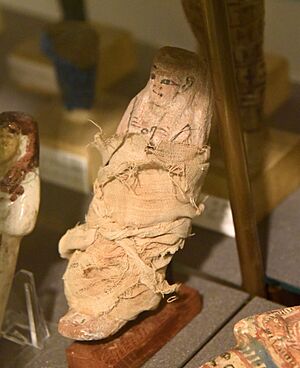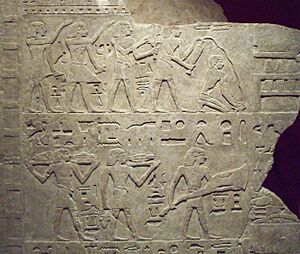Heracleopolis Magna facts for kids
|
nn nswt
|
|
| Location | Beni Suef Governorate, Egypt |
|---|---|
| Coordinates | 29°5′8″N 30°56′4″E / 29.08556°N 30.93444°E |
| Type | Settlement |
Heracleopolis Magna was an important ancient city in Egypt. Its name means "Great City of Heracles" in Greek. The ancient Egyptians called it nn nswt, which meant "Child of the King."
This city was the capital of the 20th region, or nome, of Upper Egypt. You can find its ruins about 15 kilometers (9 miles) west of the modern city of Beni Suef. Today, the area is known as Ihnasiyyah.
Contents
What's in a Name?
The ancient Egyptians had a special name for Heracleopolis Magna: nn nswt. This name means "Child of the King." It was also sometimes written as hnn nswt or hwt nn nswt.
Later, the name changed to something like Ahnās in Arabic. Today, people call the site Ihnasiyyah Umm al-Kimam or Ihnasiyyah al-Madinah.
The Greek name, "City of Heracles," came about because the Greeks connected the Egyptian god Heryshaf with their own hero, Heracles. The word "Magna" (meaning "great") was added to tell it apart from other towns with similar names. The Romans later used a Latin version of this Greek name.
Some experts also think that the biblical city of Hanes, mentioned in the book of Isaiah, might be Heracleopolis Magna.
A Look Back: History of Heracleopolis
Early Beginnings
We don't know exactly when Heracleopolis was first settled. However, a very old stone tablet called the Palermo Stone mentions it. It says that King Den visited the sacred lake of Heryshef in a place called Nenj-neswt. This suggests the city was already around by 2970 BC, during Egypt's First Dynasty.
Rise to Power: First Intermediate Period
Heracleopolis became very important during the First Intermediate Period (2181–2055 BC). After the Old Kingdom fell apart, Egypt was split into two parts: Upper and Lower Egypt. Heracleopolis became the main city of Lower Egypt. It controlled a large part of that region.
Because of its power, experts sometimes call the time between the 9th and 10th Dynasties (2160–2025 BC) the "Herakleopolitan Period." During this time, Heracleopolis often fought with Thebes, which was the main city of Upper Egypt.
Middle Kingdom Era
Heracleopolis Magna and its rulers were eventually defeated by Mentuhotep II around 2055 BC. This marked the start of the Middle Kingdom.
During this period, the city became a major religious center for the god Heryshaf. A large temple dedicated to Heryshaf was built there.
Third Intermediate Period
Heracleopolis became important again during the Third Intermediate Period (1069–664 BC). Many parts of the temple and burial sites in the city were repaired and new ones were built. It once again became a key religious and political place.
Greek and Roman Times
Even during the Ptolemaic Kingdom (332–30 BC), when Greek rulers were in charge, Heracleopolis remained a significant religious and cultural center. The Greeks connected the Egyptian god Heryshaf with their hero Heracles. This is why the city got its Greek name, Heracleopolis.
The site continued to be lived in during Roman times (30 BC–390 AD). Houses from this period have been found near the ancient burial grounds, showing that people still lived and worked there.
Famous People from Heracleopolis
- Theophanes: A scientist who studied how the world works.
Digging Up the Past: Archaeological Finds

The first person to dig a lot at Heracleopolis was a Swiss Egyptologist named Édouard Naville. He thought he had found everything there was to find in the Temple of Heryshef.
However, his friend Sir Flinders Petrie believed there was much more to discover. In 1879, Petrie started his own excavations. He called the site Ehnasya, using a name from its Roman period.
Petrie found many things Naville had missed. He finished digging out the Temple of Heryshef. He also found remains of a Roman-era house and another temple from the 19th Dynasty. Petrie's team uncovered many artifacts from different time periods, including pottery from the 11th Dynasty and iron tools and pottery from the Roman period.
Recent Discoveries
While Petrie's work was very famous, other teams have also made important finds. In the 1980s, a Spanish team found a special altar for pouring offerings and a pair of decorated eyes, likely from a statue. These items were from a temple dating to the Third Intermediate Period.
More recently, in 2008, another Spanish team led by María del Carmen Pérez-Die found a new tomb. This tomb had several "false doors" and funeral offerings, and it had not been robbed! It dated back to the First Intermediate Period.
Other finds include the funeral chapel of a high-ranking official named Neferjau and his wife Sat-Bahetep. They also found the remains of a tomb belonging to an officer named Khety from the late 11th Dynasty.



